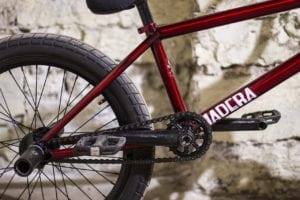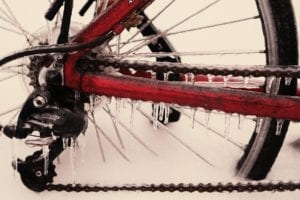With winter on its way (or so we hear), many people are preparing themselves to be cooped up indoors for months on end without reprieve. Instead, why not outfit your bike for winter and get some fresh air while commuting to work? Sure, it may seem like a silly idea. Who would possibly want to ride their bikes in the snow, right? While it’s true that winter cycling is a brave adventure, with the right preparations, it can be a great way to get through the winter months. Canada has been lucky enough to get a pretty long fall, so before winter hits hard, prep your bicycle so that you do not slip and die when the snow finally arrives.

First and foremost: protective winter clothing is essential to make sure you don’t get too cold while cycling. High winds can be harmful (especially to fingers and toes). A thermal layer for your legs and cycling gloves are the most important pieces of winter clothing you can buy. Cycling gloves specifically are built to be wind resistant, but are still flexible enough that you can still use your hands properly in the case of a flat tire. Wearing layers is the best way to ride comfortably in low temperatures, but at the same time too many bulky sweaters will prevent you from riding properly — not to mention it will cause you to sweat, which will further decrease your body temperature. Instead, look into buying thinner thermal layers that help contain core heat that will still allow you to move easily on the bike.

Your next task is to consider what kind of tires you would like to ride with in the winter season. If winter has a light snow fall, it is possible to reduce the air pressure in your regular tires and ride at 50 psi, though this is often considered the ‘poor man’s’ approach and not highly recommended. Instead, I recommend purchasing studded tires or trying out a fat bike for the winter. These bikes have the thickest and strongest tires and will prevent slipping and sliding on the wet roads. Road bike tires, a popular commuting tire that is quite thin, are to be avoided at all costs. If you don’t slide and fall first, your tires will go flat easily in rough winter road conditions. Be sure to get your brakes checked prior to winter riding to make sure you have the best braking system possible for slippery hills.
Fenders, side panels that block the wheels from the seat post, are a must for winter riding in slushy conditions. Getting splashed by snow and mud is distracting and unpleasant. The salt and snow from the roads can get stuck in hard to reach places,which can damage your bike. Fenders can be costly, but the added safety makes them worth it.

Once you are all set up with your new winter gear and are ready to ride, make sure you have cleaning supplies waiting at home near the door. Wiping down your bike after each ride will ensure it will be usable after the winter season is over. Winter can be really hard on bikes and I recommended not using a high-end bike during the colder months. Your bike chain will rust if you don’t dry it after each ride. Choose a cheaper bike if possible and be diligent about maintaining your machine so that you can keep using it.
Good luck on your winter ride and remember to be prepared and wear a helmet! Extreme winter conditions may seem intimidating for cyclists, but if you take the proper steps you will enjoy your commute. It is refreshing to be outside once you adjust to the cold, and cycling will keep your blood pumping.
What are your winter cycling essentials? Let Women’s Post know in the comments below.


